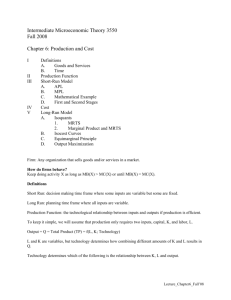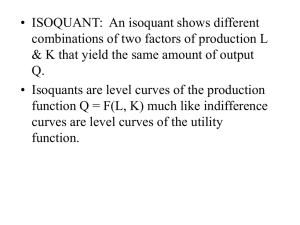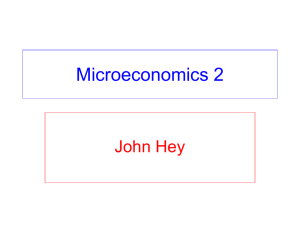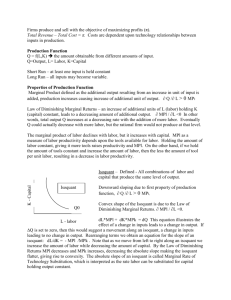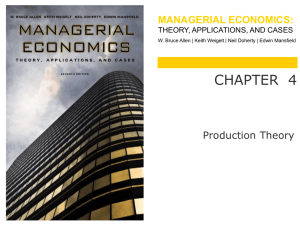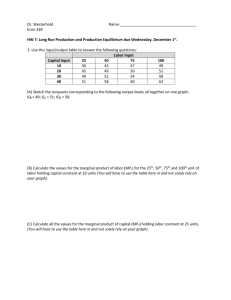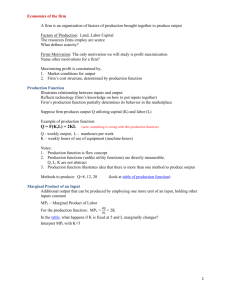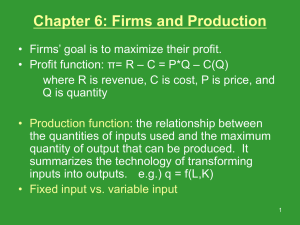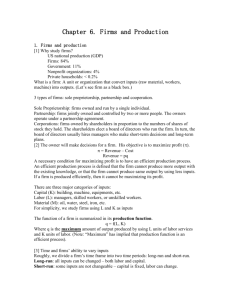Managerial Economics
advertisement
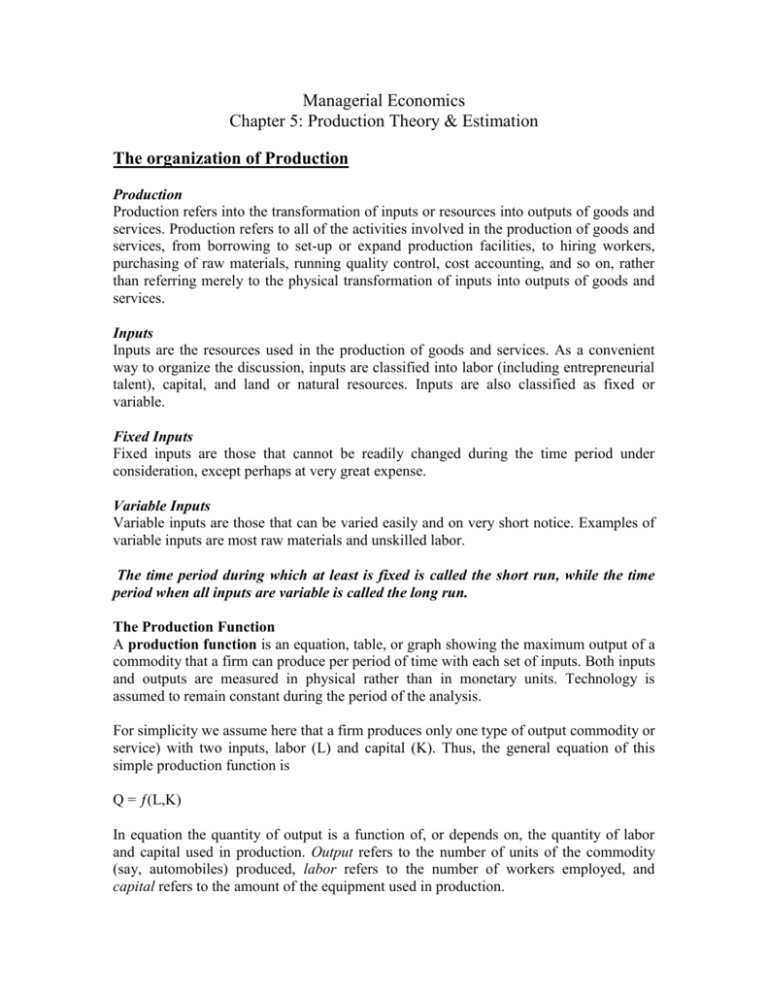
Managerial Economics Chapter 5: Production Theory & Estimation The organization of Production Production Production refers into the transformation of inputs or resources into outputs of goods and services. Production refers to all of the activities involved in the production of goods and services, from borrowing to set-up or expand production facilities, to hiring workers, purchasing of raw materials, running quality control, cost accounting, and so on, rather than referring merely to the physical transformation of inputs into outputs of goods and services. Inputs Inputs are the resources used in the production of goods and services. As a convenient way to organize the discussion, inputs are classified into labor (including entrepreneurial talent), capital, and land or natural resources. Inputs are also classified as fixed or variable. Fixed Inputs Fixed inputs are those that cannot be readily changed during the time period under consideration, except perhaps at very great expense. Variable Inputs Variable inputs are those that can be varied easily and on very short notice. Examples of variable inputs are most raw materials and unskilled labor. The time period during which at least is fixed is called the short run, while the time period when all inputs are variable is called the long run. The Production Function A production function is an equation, table, or graph showing the maximum output of a commodity that a firm can produce per period of time with each set of inputs. Both inputs and outputs are measured in physical rather than in monetary units. Technology is assumed to remain constant during the period of the analysis. For simplicity we assume here that a firm produces only one type of output commodity or service) with two inputs, labor (L) and capital (K). Thus, the general equation of this simple production function is Q = ƒ(L,K) In equation the quantity of output is a function of, or depends on, the quantity of labor and capital used in production. Output refers to the number of units of the commodity (say, automobiles) produced, labor refers to the number of workers employed, and capital refers to the amount of the equipment used in production. The Production Function with One Variable Input By holding the quantity of one input constant and changing the quantity used of the other input, we can derive the total product (TP) of the variable input. For example, by holding capital constant at 1 unit (i.e., with K=1) and increasing the units of labor used from zero to 6 units, we generate the total product of labor given by the 2 column in Table bellow. From the total product schedule we can derive the marginal and average product schedules of the variable input. The marginal product (MP) of labor (MPL) is the change in total product or extra output per unit change in labor used, while the average product (AP) of labor (APL) equals total product divided by the quantity of labor used. That is, MPL TP L APL TP L Production or Output Elasticity of labor (EL) This measures the percentage change in output divided by the percentage change in the quantity of labor. That is, EL % Q % L Table: Total, Marginal, and Average Product of Labor, and Output Elasticity (1) (2) (3) (4) (5) Labor TP MP AP Elasticity of Labor 0 0 1 3 3 3 1 2 8 5 4 1.25 3 12 4 4 1 4 14 2 3.5 0.57 5 14 0 2.8 0 6 12 -2 2 -1 Figure: Total, Marginal, and Average Product of Labor Curves The top panel shows the total product of labor curve. TP is highest between 4L and 5L. The bottom panel shows the marginal and the average product of labor curves. The MPL is plotted halfway between successive units of labor used. The MPL curve rises up to 1.5L and then declines, and it becomes negative past 4.5L. The APL is highest between 2L and 3L. Figure: The Law of Diminishing Returns and Stages of Production With labor time continuously divisible, we have smooth TP, MP, and AP curves. The MPL (Given by the slope of the tangent to the TP curve) rise up to point G/ , becomes zero at J/ , and is negative thereafter. The APL (Given by the slope of the ray from the origin to a point on the TP curve) rise up to point H/ and declines thereafter (but remains positive as long as TP is positive). Stage I of production for labor corresponds to the rising portion of the APL. Stage II covers the range from maximum APL to where MPL is zero. Stage III occurs when MPL is negative. Tshe Production Function with Two Variable Inputs Production ISOQuants An isoquant swos the various combinations of two inputs (say labor and capital) that the firm can use to produce a specific level of output A higher isoquant refers to a large output where a lower isoquant refers to a smaller output. Economic Region of Production While the isoquants have positively sloped potions, these portions are irrelevant. That is, the firm would not operate on the positively sloped portion of an isoquant because it could produce the same level of output with less capital and less labor. Ridge lines separate the relevant (i.e., negatively sloped) from the irrelevant (or positively sloped) portions of the isoquants. Marginal Rate of Technical Substitution The absolute value of the slope of the isoquant is called the marginal rate of technical substitute (MRTS). For a movement down along an isoquant, the marginal rate jof technical substitution of labor for capital is given by K / L. We multiply K / L by -1 in order to express the MRTS as a positive number. Thus, the MRTS between points N and R on the isoquant for 12Q is 2.5. Similarly, the MRTS between points R and is ½. The MRTS at any point on an isoquant is given by the absolute slope of the isoquant at that point. Thus, the MRTS at point R is 1. ISOcost Lines An isocost line shows the various combinations of inputs that a firm can purchase or hire at a given cost. By the use of isocosts and isoquants, we will then determine the optimal input combination for the firm to maximize profits. Suppose that a firm uses only labor and capital in production. The total coists or expenditures of the firm can then be presented by C = wL + rK Where C is total costs, w is the wage rate of labor, L is the quantity of labor used, r is the rental price of capital, and K is the quantity of capital used. Thus, equation postulates that the total costs of the firm © equals the sum of its expenditures on labor (wL) and capital (rK). For example, if C = $ 100, w = $10, and r = $10, the firm could either hire 10L or rent 10K, or any combination of L and L within the total cost of $ 100. For each unit of capital the firm gives up, it can hire one additional unit of labor. Thus, the slope of the isocost line is -1. By subtracting wL from both sides of Equation and then dividing by r, we get the general equation of the isocost line is the following more useful form: C w L r r where C/r is the vertical intercept of the isocost line and –w/r is its slope. Thus, for C=$100 and w = r = $10, the vertical intercept is C/r = $100/$10 = 10K, and the slope is –w/r = -$10/$10 = -1. A different total cost y the firm would define a different but parallel isocost line, while different relatives input prices would define an isocost line with a different slope. K Returns to Scale Returns to scale refers to the degree by which output changes as a result of a given change in the quantity of all inputs used in production. There are three types of returns to scale: constant, increasing, and decreasing. If the quantity of all inputs used in production is increased by a given proportion, we have constant returns to scale if output increases in the same proportion; increasing returns to scale if output increases by a greater proportion; and decreasing returns to scale if output increases by a smaller proportion. That is, suppose that starting with the general production function Q ( L, K ) we multiply L and K by h, and Q increases by 1, as indicated in Equation Q (hL, hK ) We have constant, increasing, or decreasing returns to scale, respectively, depending on whether h, h, or , h.
